
The bay leaf is an aromatic leaf commonly used as a herb in cooking. It can be used whole, either dried or fresh, in which case it is removed from the dish before consumption, or less commonly used in ground form. The flavor that a bay leaf imparts to a dish has not been universally agreed upon, but many agree it is a subtle addition.
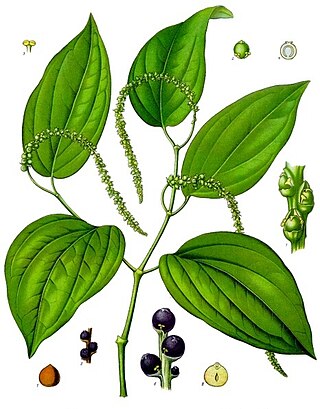
Black pepper is a flowering vine in the family Piperaceae, cultivated for its fruit, which is usually dried and used as a spice and seasoning. The fruit is a drupe (stonefruit) which is about 5 mm (0.20 in) in diameter, dark red, and contains a stone which encloses a single pepper seed. Peppercorns and the ground pepper derived from them may be described simply as pepper, or more precisely as black pepper, green pepper, or white pepper.
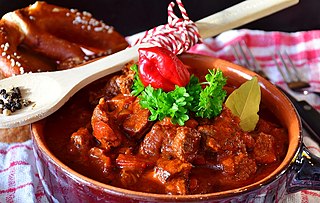
Hungarian or Magyar cuisine is the cuisine characteristic of the nation of Hungary, and its primary ethnic group, the Magyars. Hungarian cuisine has been described as being the spiciest cuisine in Europe. This can largely be attributed to the use of their piquant native spice, Hungarian paprika, in many of their dishes. A mild version of the spice, Hungarian sweet paprika, is commonly used as an alternative. Traditional Hungarian dishes are primarily based on meats, seasonal vegetables, fruits, bread, and dairy products.

A chipotle, or chilpotle, is a smoke-dried ripe jalapeño chili pepper used for seasoning. It is a chili used primarily in Mexican and Mexican-inspired cuisines, such as Tex-Mex and Southwestern United States dishes. It comes in different forms, such as chipotles en adobo.
Jamaican cuisine includes a mixture of cooking techniques, flavours and spices influenced by Amerindian, West African, Irish, English, French, Portuguese, Spanish, Indian, Chinese and Middle Eastern people who have inhabited the island. It is also influenced by the crops introduced into the island from tropical Southeast Asia, many of which are now grown locally. A wide variety of seafood, tropical fruits and meats are available.
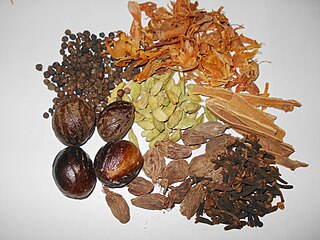
Spice mixes are blended spices or herbs. When a certain combination of herbs or spices is called for in a recipe, it is convenient to blend these ingredients beforehand. Blends such as chili powder, curry powder, herbes de Provence, garlic salt, and other seasoned salts are traditionally sold pre-made by grocers, and sometimes baking blends such as pumpkin pie spice are also available. These spice mixes are also easily made by the home cook for later use.
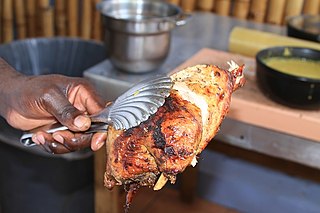
Jerk is a style of cooking native to Jamaica, in which meat is dry-rubbed or wet marinated with a hot spice mixture called Jamaican jerk spice.

Callaloo is a plant used in popular dishes in many Caribbean countries, while for other Caribbean countries, a stew made with the plant is called callaloo. Cuisines, including the plant callaloo or dishes called callaloo, vary throughout the Caribbean. In countries such as Trinidad and Tobago or Grenada, the dish itself is called callaloo and uses taro leaves or Xanthosoma leaves.
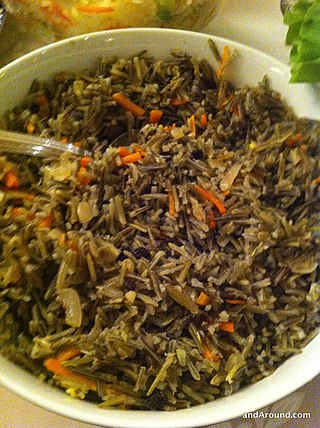
Indigenous cuisine of the Americas includes all cuisines and food practices of the Indigenous peoples of the Americas. Contemporary Native peoples retain a varied culture of traditional foods, along with the addition of some post-contact foods that have become customary and even iconic of present-day Indigenous American social gatherings. Foods like cornbread, turkey, cranberry, blueberry, hominy, and mush have been adopted into the cuisine of the broader United States population from Native American cultures.

The cuisine of the Democratic Republic of the Congo and the Republic of the Congo varies widely, representing the food of indigenous people. Cassava, fufu, rice, plantain and potatoes are generally the staple foods eaten with other side dishes.

Pimenta is a genus of flowering plants in the myrtle family, Myrtaceae described as a genus in 1821. It is native to Central and South America, Mexico, and the West Indies.
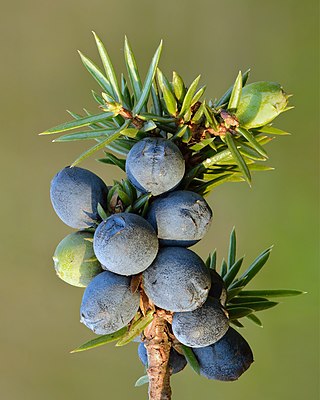
A juniper berry is the female seed cone produced by the various species of junipers. It is not a true berry but a cone with unusually fleshy and merged scales called a galbulus, which gives it a berry-like appearance. The cones from a handful of species, especially Juniperus communis, are used as a spice, particularly in European cuisine, and also give gin its distinctive flavour. Juniper berries are among the only spices derived from conifers, along with spruce buds.

Hungarian sausages are sausages found in the cuisine of Hungary. Hungary produces a vast number of sui sausage types. They may be boiled, fresh or dried, and smoked, with different spices and flavors, "hot" or "mild". Many were influenced by their neighbors and brethren.

West African cuisine encompasses a diverse range of foods that are split between its 16 countries. In West Africa, many families grow and raise their own food, and within each there is a division of labor. Indigenous foods consist of a number of plant species and animals, and are important to those whose lifestyle depends on farming and hunting.

Mizrahi Jewish cuisine is an assortment of cooking traditions that developed among the Mizrahi Jewish communities of the Middle East, North Africa and Central Asia. Influenced by the diverse local culinary practices of countries such as Morocco, Libya, Egypt, Iraq, Iran, Yemen, and Syria, Mizrahi cuisine prominently features rice, legumes, meats, and an array of spices such as cumin, turmeric, and coriander. Signature dishes include kubbeh (dumplings), pilafs, grilled meats, and stews like hamin.

Chadian cuisine is the cooking traditions, practices, foods and dishes associated with the Republic of Chad. Chadians use a medium variety of grains, vegetables, fruits and meats. Commonly consumed grains include millet, sorghum, and rice as staple foods. Commonly eaten vegetables include okra and cassava. A variety of fruits are also eaten. Meats include mutton, chicken, pork, goat, fish, lamb and beef. The day's main meal is typically consumed in the evening on a large communal plate, with men and women usually eating in separate areas. This meal is typically served on the ground upon a mat, with people sitting and eating around it.
The following outline is provided as an overview of and topical guide to herbs and spices:



















